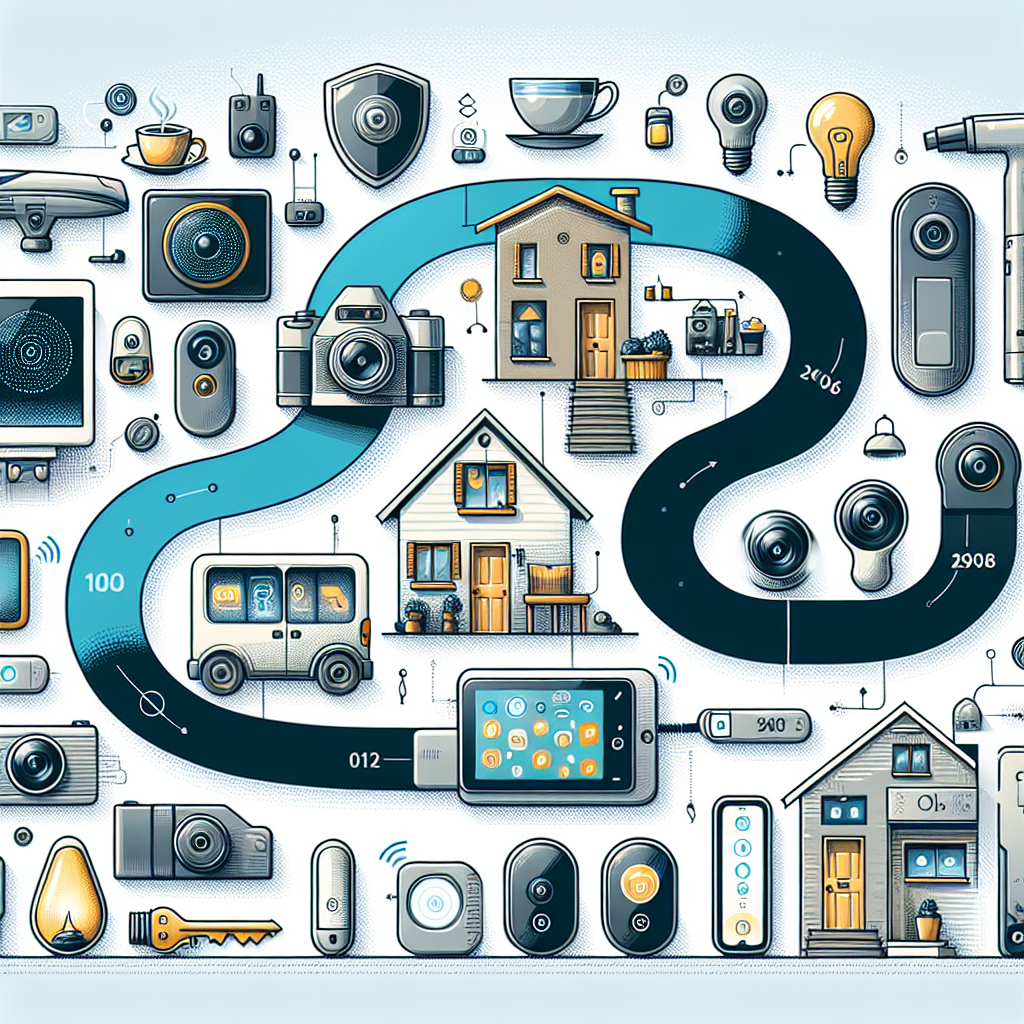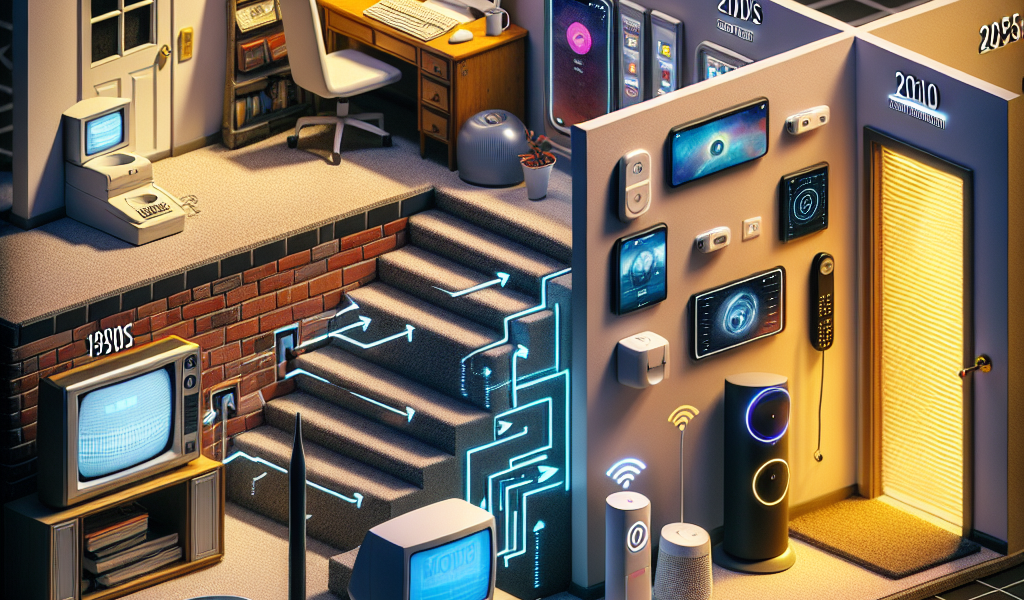-
Table of Contents
“Smart Home Evolution: Where Convenience and Security Converge”
Introduction

The Evolution of Smart Home Technology: Convenience Meets Security
The rapid advancement of smart home technology has revolutionized the way we interact with our living spaces, seamlessly blending convenience with enhanced security. From the early days of basic home automation systems to the sophisticated, interconnected ecosystems of today, smart home technology has evolved to offer unprecedented control and peace of mind. This evolution has been driven by innovations in artificial intelligence, the Internet of Things (IoT), and wireless communication, enabling homeowners to manage everything from lighting and climate control to security systems and household appliances with a simple voice command or a tap on their smartphone. As these technologies continue to advance, the integration of convenience and security in smart homes promises to redefine modern living, making our homes not only more efficient and comfortable but also safer and more secure.
The Rise of Voice-Activated Assistants in Smart Homes
The advent of smart home technology has revolutionized the way we interact with our living spaces, blending convenience with enhanced security. Among the myriad innovations, voice-activated assistants have emerged as a pivotal component, transforming the dynamics of modern households. These devices, powered by artificial intelligence, have not only simplified daily routines but also fortified home security measures, creating a seamless integration of technology into our everyday lives.
Voice-activated assistants, such as Amazon’s Alexa, Google Assistant, and Apple’s Siri, have become ubiquitous in contemporary homes. Their rise can be attributed to their ability to perform a wide array of tasks through simple voice commands. From setting reminders and controlling smart appliances to providing real-time information and entertainment, these assistants have become indispensable. The convenience they offer is unparalleled, allowing users to manage their homes effortlessly, even from a distance.
Moreover, the integration of voice-activated assistants with other smart home devices has further amplified their utility. For instance, these assistants can be synchronized with smart thermostats, lighting systems, and security cameras, enabling users to control their home environment with ease. This interconnected ecosystem not only enhances the user experience but also contributes to energy efficiency and cost savings. By adjusting settings based on user preferences and habits, these systems ensure optimal performance and reduced energy consumption.
In addition to convenience, voice-activated assistants have significantly bolstered home security. They can be integrated with smart locks, alarm systems, and surveillance cameras, providing homeowners with real-time updates and control over their security apparatus. For example, users can lock or unlock doors, monitor security footage, and receive alerts about suspicious activities, all through voice commands. This level of control and immediacy is invaluable, particularly in emergency situations where time is of the essence.
Furthermore, advancements in artificial intelligence have enabled voice-activated assistants to recognize and respond to individual voices, adding an extra layer of security. This voice recognition feature ensures that only authorized users can access certain functions, thereby preventing unauthorized access. Additionally, these assistants can be programmed to perform specific actions when certain keywords or phrases are detected, such as alerting authorities or activating security protocols in case of a break-in.
However, the rise of voice-activated assistants has not been without challenges. Privacy concerns have been a significant issue, as these devices are always listening for their wake words, raising questions about data security and potential misuse. Tech companies have been working diligently to address these concerns by implementing robust encryption methods and providing users with greater control over their data. Transparency about data collection practices and offering options to delete voice recordings are steps in the right direction, aiming to build trust and ensure user privacy.
As voice-activated assistants continue to evolve, their role in smart homes is expected to expand further. Innovations such as natural language processing and machine learning will enhance their capabilities, making them more intuitive and responsive to user needs. The integration of these assistants with emerging technologies like the Internet of Things (IoT) and 5G networks will also open new avenues for smart home automation, creating a more connected and efficient living environment.
In conclusion, the rise of voice-activated assistants in smart homes epitomizes the convergence of convenience and security. These devices have transformed the way we interact with our homes, offering unparalleled ease of use and enhanced control over our living spaces. While challenges remain, ongoing advancements and efforts to address privacy concerns will ensure that voice-activated assistants continue to play a pivotal role in the evolution of smart home technology.
Integrating AI and Machine Learning for Enhanced Home Security
The integration of artificial intelligence (AI) and machine learning into smart home technology has revolutionized the way we think about home security. As these technologies continue to evolve, they offer unprecedented levels of convenience and protection, transforming our living spaces into intelligent environments capable of anticipating and responding to our needs. This seamless blend of convenience and security is reshaping the landscape of home automation, making it more intuitive and reliable than ever before.
AI and machine learning have become the backbone of modern smart home security systems. These technologies enable devices to learn from user behavior, adapt to changing conditions, and make real-time decisions that enhance safety. For instance, AI-powered cameras can distinguish between a family member, a pet, and an intruder, reducing the likelihood of false alarms. This capability not only provides peace of mind but also ensures that security measures are activated only when necessary, thereby optimizing energy consumption and system efficiency.
Moreover, the integration of AI into smart home security extends beyond mere surveillance. Machine learning algorithms can analyze patterns in data collected from various sensors and devices throughout the home. This analysis allows the system to predict potential security threats and take preemptive actions. For example, if the system detects unusual activity, such as repeated attempts to access a locked door, it can alert the homeowner and even contact emergency services if needed. This proactive approach to security is a significant advancement over traditional reactive systems, which often only respond after a breach has occurred.
In addition to enhancing security, AI and machine learning contribute to the overall convenience of smart home systems. Voice-activated assistants, such as Amazon’s Alexa and Google Assistant, have become central hubs for managing home security. These devices can control locks, cameras, and alarm systems through simple voice commands, making it easier for homeowners to monitor and secure their properties. Furthermore, the integration of AI allows these assistants to understand context and provide more accurate responses. For instance, if a homeowner asks about the status of their security system, the assistant can provide a detailed report, including any recent activity and potential issues.
The convenience of AI-driven smart home security is further amplified by the ability to integrate with other smart devices. For example, smart lighting systems can be programmed to simulate occupancy when the homeowner is away, deterring potential intruders. Similarly, smart thermostats can adjust the temperature based on the presence of individuals in the home, ensuring comfort while also conserving energy. These interconnected systems create a cohesive and responsive environment that enhances both security and convenience.
However, the increasing reliance on AI and machine learning in smart home security also raises important considerations regarding privacy and data security. As these systems collect and analyze vast amounts of personal data, ensuring that this information is protected from unauthorized access is paramount. Manufacturers and developers must prioritize robust encryption methods and secure data storage solutions to safeguard user information. Additionally, transparent policies regarding data usage and user consent are essential to maintaining trust and confidence in these technologies.
In conclusion, the integration of AI and machine learning into smart home technology represents a significant leap forward in both convenience and security. By enabling systems to learn, adapt, and respond proactively, these technologies offer a level of protection that was previously unattainable. As we continue to embrace these advancements, it is crucial to address the associated privacy concerns to ensure that the benefits of smart home security are fully realized without compromising user trust. The future of home security lies in the intelligent interplay between technology and human needs, creating safer and more convenient living environments for all.
The Role of IoT Devices in Modern Smart Home Ecosystems
The rapid advancement of smart home technology has revolutionized the way we interact with our living spaces, seamlessly blending convenience with security. Central to this transformation is the Internet of Things (IoT), a network of interconnected devices that communicate and collaborate to create a cohesive and intelligent home environment. As IoT devices become more sophisticated, their role in modern smart home ecosystems continues to expand, offering unprecedented levels of control and efficiency.
Initially, smart home technology focused primarily on convenience, with devices such as smart thermostats and lighting systems allowing homeowners to manage their environments with ease. However, as the technology evolved, the integration of IoT devices began to address a broader range of needs, including security. Today, IoT-enabled security systems are a cornerstone of smart home ecosystems, providing real-time monitoring and alerts that enhance the safety of our homes.
One of the most significant contributions of IoT devices to smart home security is the ability to create a comprehensive and interconnected security network. Traditional security systems often relied on isolated components, such as standalone cameras or alarm systems, which operated independently. In contrast, modern IoT security devices, such as smart cameras, doorbell cameras, and motion sensors, are designed to work together, sharing information and responding to potential threats in a coordinated manner. This interconnected approach not only improves the effectiveness of security measures but also allows for more efficient management and control.
Moreover, the integration of artificial intelligence (AI) and machine learning with IoT devices has further enhanced their capabilities. For instance, AI-powered security cameras can now distinguish between different types of motion, such as a person walking versus a tree branch swaying in the wind, reducing the number of false alarms. Additionally, these cameras can learn and adapt to the specific patterns of activity in a home, providing more accurate and reliable security monitoring over time.
In addition to security, IoT devices play a crucial role in enhancing the overall convenience and efficiency of smart home ecosystems. Smart assistants, such as Amazon’s Alexa and Google Assistant, serve as central hubs that connect and control various IoT devices, allowing homeowners to manage their homes through simple voice commands. This level of integration extends to other aspects of home management, such as energy consumption and appliance control. For example, smart thermostats can learn a homeowner’s schedule and preferences, adjusting the temperature automatically to optimize comfort and energy efficiency.
Furthermore, IoT devices contribute to the sustainability of smart homes by enabling more efficient use of resources. Smart irrigation systems, for instance, can monitor weather conditions and soil moisture levels to determine the optimal watering schedule for a garden, reducing water waste. Similarly, smart lighting systems can adjust the intensity and color of lights based on the time of day and occupancy, minimizing energy consumption.
As the adoption of IoT devices in smart home ecosystems continues to grow, so too does the importance of addressing potential security and privacy concerns. The interconnected nature of these devices means that a vulnerability in one component can potentially compromise the entire system. Therefore, manufacturers and developers must prioritize robust security measures, such as encryption and regular software updates, to protect against cyber threats.
In conclusion, the evolution of smart home technology, driven by the integration of IoT devices, has created a harmonious blend of convenience and security. By enabling seamless communication and collaboration between devices, IoT technology has transformed our homes into intelligent environments that cater to our needs while safeguarding our well-being. As this technology continues to advance, it promises to further enhance the quality of life for homeowners, making smart homes an integral part of our modern lives.
Future Trends in Smart Home Technology: What to Expect
As smart home technology continues to evolve, the intersection of convenience and security remains a focal point for both consumers and developers. The future of smart home technology promises to bring even more sophisticated innovations that will not only enhance our daily lives but also ensure that our homes are safer than ever before. One of the most anticipated trends in this domain is the integration of artificial intelligence (AI) and machine learning. These technologies are expected to make smart home systems more intuitive and responsive. For instance, AI-driven systems will be able to learn the habits and preferences of homeowners, adjusting lighting, temperature, and even security settings automatically. This level of personalization will make smart homes more efficient and user-friendly, reducing the need for manual adjustments.
In addition to AI, the Internet of Things (IoT) will continue to play a crucial role in the development of smart home technology. The proliferation of IoT devices means that more household items will be interconnected, allowing for seamless communication between various systems. This interconnectedness will enable more comprehensive home automation solutions, where everything from kitchen appliances to security cameras can be controlled through a single interface. As a result, homeowners will enjoy a more streamlined and cohesive smart home experience.
Security, however, remains a paramount concern as smart home technology advances. With the increasing number of connected devices, the potential for cyber threats also rises. Future trends in smart home technology will likely focus on enhancing cybersecurity measures to protect against these threats. Advanced encryption methods, multi-factor authentication, and regular software updates will become standard features in smart home systems. Moreover, developers are expected to implement more robust security protocols to safeguard personal data and ensure that smart home devices are not vulnerable to hacking.
Another significant trend to watch is the rise of voice-activated assistants. While these have already gained popularity, future iterations will be more sophisticated, offering greater accuracy and a wider range of functionalities. Voice-activated assistants will not only control smart home devices but also provide real-time information and support, making them indispensable tools for modern living. The integration of natural language processing will further enhance their capabilities, allowing for more natural and intuitive interactions between users and their smart home systems.
Sustainability is also set to become a key focus in the evolution of smart home technology. As environmental concerns grow, there will be a greater emphasis on developing energy-efficient solutions. Smart home systems will incorporate features that monitor and optimize energy usage, reducing waste and lowering utility bills. Renewable energy sources, such as solar panels, will be integrated into smart home ecosystems, providing sustainable power options. This shift towards eco-friendly technology will not only benefit the environment but also appeal to the growing number of environmentally conscious consumers.
Lastly, the future of smart home technology will likely see greater interoperability between different brands and platforms. Currently, one of the challenges faced by consumers is the lack of compatibility between various smart home devices. However, industry leaders are working towards creating universal standards that will allow for seamless integration across different systems. This will make it easier for consumers to build and expand their smart home setups without being restricted to a single brand or platform.
In conclusion, the future of smart home technology is poised to bring about significant advancements in convenience, security, and sustainability. With the integration of AI, IoT, enhanced cybersecurity measures, voice-activated assistants, and a focus on energy efficiency, smart homes will become more intuitive, secure, and environmentally friendly. As these trends continue to develop, homeowners can look forward to a more connected and efficient living experience.
Conclusion
The evolution of smart home technology has seamlessly integrated convenience and security, transforming how we interact with our living spaces. Advanced automation, interconnected devices, and enhanced security measures have not only simplified daily tasks but also provided robust protection against potential threats. As technology continues to advance, the synergy between convenience and security in smart homes is expected to further enhance the quality of life, making homes more efficient, safe, and responsive to the needs of their inhabitants.





